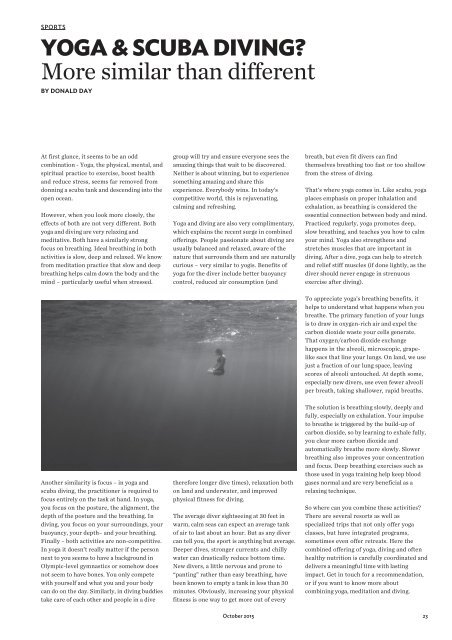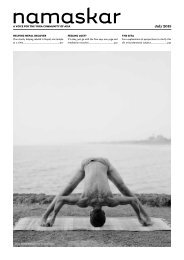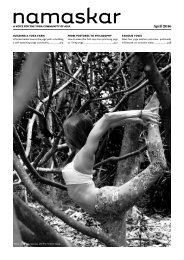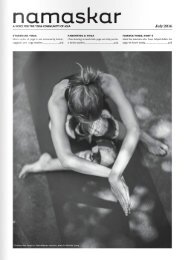Namaskar Oct 2015
Create successful ePaper yourself
Turn your PDF publications into a flip-book with our unique Google optimized e-Paper software.
SPORTS<br />
YOGA & SCUBA DIVING?<br />
More similar than different<br />
BY DONALD DAY<br />
At first glance, it seems to be an odd<br />
combination - Yoga, the physical, mental, and<br />
spiritual practice to exercise, boost health<br />
and reduce stress, seems far removed from<br />
donning a scuba tank and descending into the<br />
open ocean.<br />
However, when you look more closely, the<br />
effects of both are not very different. Both<br />
yoga and diving are very relaxing and<br />
meditative. Both have a similarly strong<br />
focus on breathing. Ideal breathing in both<br />
activities is slow, deep and relaxed. We know<br />
from meditation practice that slow and deep<br />
breathing helps calm down the body and the<br />
mind – particularly useful when stressed.<br />
group will try and ensure everyone sees the<br />
amazing things that wait to be discovered.<br />
Neither is about winning, but to experience<br />
something amazing and share this<br />
experience. Everybody wins. In today’s<br />
competitive world, this is rejuvenating,<br />
calming and refreshing.<br />
Yoga and diving are also very complimentary,<br />
which explains the recent surge in combined<br />
offerings. People passionate about diving are<br />
usually balanced and relaxed, aware of the<br />
nature that surrounds them and are naturally<br />
curious – very similar to yogis. Benefits of<br />
yoga for the diver include better buoyancy<br />
control, reduced air consumption (and<br />
breath, but even fit divers can find<br />
themselves breathing too fast or too shallow<br />
from the stress of diving.<br />
That’s where yoga comes in. Like scuba, yoga<br />
places emphasis on proper inhalation and<br />
exhalation, as breathing is considered the<br />
essential connection between body and mind.<br />
Practiced regularly, yoga promotes deep,<br />
slow breathing, and teaches you how to calm<br />
your mind. Yoga also strengthens and<br />
stretches muscles that are important in<br />
diving. After a dive, yoga can help to stretch<br />
and relief stiff muscles (if done lightly, as the<br />
diver should never engage in strenuous<br />
exercise after diving).<br />
To appreciate yoga’s breathing benefits, it<br />
helps to understand what happens when you<br />
breathe. The primary function of your lungs<br />
is to draw in oxygen-rich air and expel the<br />
carbon dioxide waste your cells generate.<br />
That oxygen/carbon dioxide exchange<br />
happens in the alveoli, microscopic, grapelike<br />
sacs that line your lungs. On land, we use<br />
just a fraction of our lung space, leaving<br />
scores of alveoli untouched. At depth some,<br />
especially new divers, use even fewer alveoli<br />
per breath, taking shallower, rapid breaths.<br />
Another similarity is focus – in yoga and<br />
scuba diving, the practitioner is required to<br />
focus entirely on the task at hand. In yoga,<br />
you focus on the posture, the alignment, the<br />
depth of the posture and the breathing. In<br />
diving, you focus on your surroundings, your<br />
buoyancy, your depth– and your breathing.<br />
Finally – both activities are non-competitive.<br />
In yoga it doesn’t really matter if the person<br />
next to you seems to have a background in<br />
Olympic-level gymnastics or somehow does<br />
not seem to have bones. You only compete<br />
with yourself and what you and your body<br />
can do on the day. Similarly, in diving buddies<br />
take care of each other and people in a dive<br />
therefore longer dive times), relaxation both<br />
on land and underwater, and improved<br />
physical fitness for diving.<br />
The average diver sightseeing at 30 feet in<br />
warm, calm seas can expect an average tank<br />
of air to last about an hour. But as any diver<br />
can tell you, the sport is anything but average.<br />
Deeper dives, stronger currents and chilly<br />
water can drastically reduce bottom time.<br />
New divers, a little nervous and prone to<br />
“panting” rather than easy breathing, have<br />
been known to empty a tank in less than 30<br />
minutes. Obviously, increasing your physical<br />
fitness is one way to get more out of every<br />
The solution is breathing slowly, deeply and<br />
fully, especially on exhalation. Your impulse<br />
to breathe is triggered by the build-up of<br />
carbon dioxide, so by learning to exhale fully,<br />
you clear more carbon dioxide and<br />
automatically breathe more slowly. Slower<br />
breathing also improves your concentration<br />
and focus. Deep breathing exercises such as<br />
those used in yoga training help keep blood<br />
gases normal and are very beneficial as a<br />
relaxing technique.<br />
So where can you combine these activities?<br />
There are several resorts as well as<br />
specialized trips that not only offer yoga<br />
classes, but have integrated programs,<br />
sometimes even offer retreats. Here the<br />
combined offering of yoga, diving and often<br />
healthy nutrition is carefully coordinated and<br />
delivers a meaningful time with lasting<br />
impact. Get in touch for a recommendation,<br />
or if you want to know more about<br />
combining yoga, meditation and diving.<br />
<strong>Oct</strong>ober <strong>2015</strong> 23








